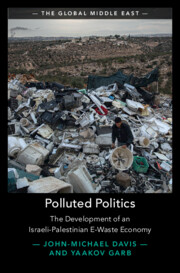175 results
War-related trauma in narratives of Gazans: challenges, difficulties and survival coping
-
- Journal:
- Cambridge Prisms: Global Mental Health / Volume 12 / 2025
- Published online by Cambridge University Press:
- 26 February 2025, e34
-
- Article
-
- You have access
- Open access
- HTML
- Export citation
Nikos Kazantzakis on Palestine, Jerusalem, and the Zionist movement: literary and historical considerations
-
- Journal:
- Byzantine and Modern Greek Studies , First View
- Published online by Cambridge University Press:
- 03 February 2025, pp. 1-23
-
- Article
-
- You have access
- Open access
- HTML
- Export citation
Internationalist Islam and the Question of Palestine
-
- Journal:
- Review of Middle East Studies , First View
- Published online by Cambridge University Press:
- 13 January 2025, pp. 1-14
-
- Article
-
- You have access
- Open access
- HTML
- Export citation
Differences in severity of depression symptoms in overweight, obese and normal weight Palestinian children and adolescents
-
- Journal:
- Cambridge Prisms: Global Mental Health / Volume 11 / 2024
- Published online by Cambridge University Press:
- 03 January 2025, e127
-
- Article
-
- You have access
- Open access
- HTML
- Export citation

Polluted Politics
- The Development of an Israeli-Palestinian E-Waste Economy
-
- Published online:
- 18 December 2024
- Print publication:
- 05 December 2024
6 - E-Waste Burning
- from Part II - Pathways and Predicaments
-
- Book:
- Polluted Politics
- Published online:
- 18 December 2024
- Print publication:
- 05 December 2024, pp 135-158
-
- Chapter
- Export citation
4 - Co-creating E-Waste Hub Futures
- from Part I - Positioning E-Waste Hubs
-
- Book:
- Polluted Politics
- Published online:
- 18 December 2024
- Print publication:
- 05 December 2024, pp 84-104
-
- Chapter
- Export citation
1 - The Emergence of E-Waste Hubs
- from Part I - Positioning E-Waste Hubs
-
- Book:
- Polluted Politics
- Published online:
- 18 December 2024
- Print publication:
- 05 December 2024, pp 3-32
-
- Chapter
- Export citation
7 - The Toxic Elephant in the Room
- from Part II - Pathways and Predicaments
-
- Book:
- Polluted Politics
- Published online:
- 18 December 2024
- Print publication:
- 05 December 2024, pp 159-180
-
- Chapter
- Export citation
3 - Crude Portrayals, Crude Proposals
- from Part I - Positioning E-Waste Hubs
-
- Book:
- Polluted Politics
- Published online:
- 18 December 2024
- Print publication:
- 05 December 2024, pp 61-83
-
- Chapter
- Export citation
5 - Can Tails Wag the Dog?
- from Part I - Positioning E-Waste Hubs
-
- Book:
- Polluted Politics
- Published online:
- 18 December 2024
- Print publication:
- 05 December 2024, pp 105-132
-
- Chapter
- Export citation
2 - The West Line E-Waste Economy
- from Part I - Positioning E-Waste Hubs
-
- Book:
- Polluted Politics
- Published online:
- 18 December 2024
- Print publication:
- 05 December 2024, pp 33-60
-
- Chapter
- Export citation
8 - Border Frictions
- from Part II - Pathways and Predicaments
-
- Book:
- Polluted Politics
- Published online:
- 18 December 2024
- Print publication:
- 05 December 2024, pp 181-204
-
- Chapter
- Export citation
Preface:
-
- Book:
- Polluted Politics
- Published online:
- 18 December 2024
- Print publication:
- 05 December 2024, pp xiii-xxv
-
- Chapter
- Export citation
9 - Open Questions, Opening Futures
- from Part II - Pathways and Predicaments
-
- Book:
- Polluted Politics
- Published online:
- 18 December 2024
- Print publication:
- 05 December 2024, pp 205-220
-
- Chapter
- Export citation
Postwar development of offshore energy resources: Legal and political models for developing the Gaza Marine gas field
-
- Journal:
- Leiden Journal of International Law , First View
- Published online by Cambridge University Press:
- 03 December 2024, pp. 1-16
-
- Article
-
- You have access
- Open access
- HTML
- Export citation
“Embodying” the Intellectual: Edward Said, Public Sphere and the University
- Part of
-
- Journal:
- Public Humanities / Volume 1 / 2025
- Published online by Cambridge University Press:
- 02 December 2024, e28
-
- Article
-
- You have access
- Open access
- HTML
- Export citation
Chapter 4 - Violent Worlds
-
- Book:
- Insurgent Cultures
- Published online:
- 07 December 2024
- Print publication:
- 28 November 2024, pp 182-224
-
- Chapter
-
- You have access
- Open access
- HTML
- Export citation
Chapter 16 - Conflict and Care: Edna O’Brien’s Girl, Colum McCann’s Apeirogon, and the Limits of Interculturality
- from Part IV - Transnational Futures
-
-
- Book:
- Transnationalism in Irish Literature and Culture
- Published online:
- 13 November 2024
- Print publication:
- 14 November 2024, pp 300-316
-
- Chapter
- Export citation
Chapter 5 - Ruin
- from Part III - “Kindred with the Mummy”
-
- Book:
- Temporal Forms and the Nineteenth-Century Mediterranean
- Published online:
- 09 November 2024
- Print publication:
- 14 November 2024, pp 169-195
-
- Chapter
- Export citation


